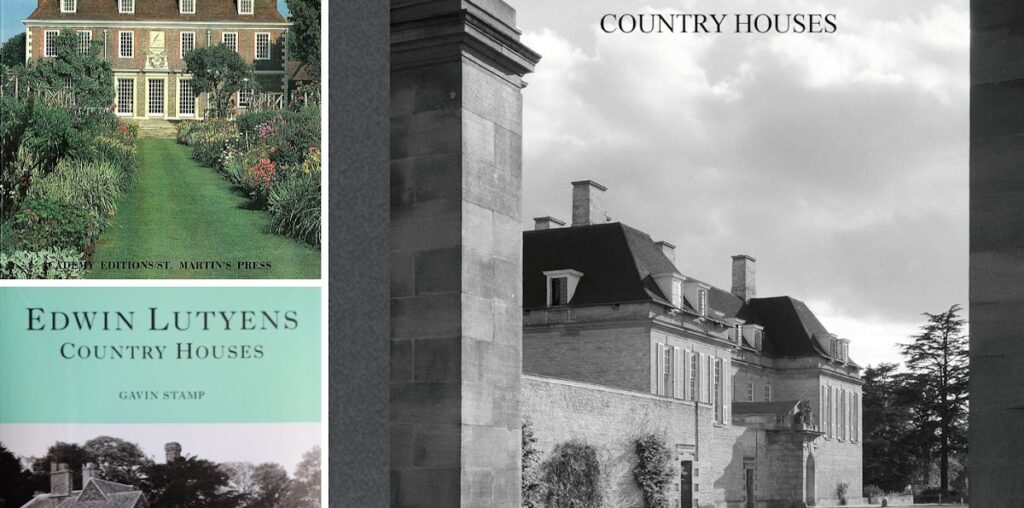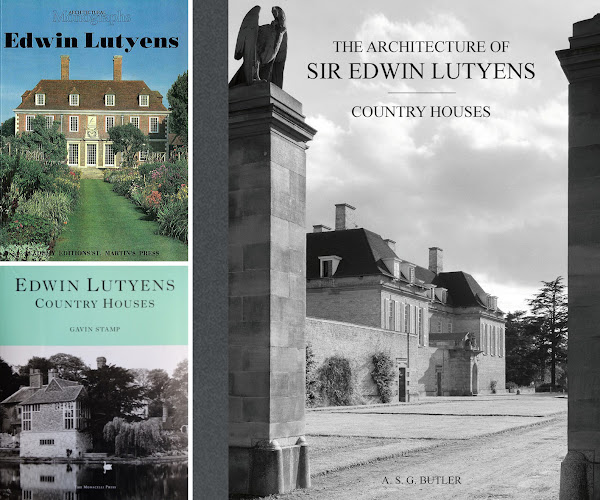Sir Edwin Landseer Lutyens, the English architect who was born in 1869 and died in 1944, that is. Although a famous name, Lutyens was not an architect I had much familiarity with before I received a review copy of the first volume of
The Architecture of Sir Edwin Lutyens. Flipping through it prompted me to do a little digging on Lutyens in other publications. Racking my brain, it seems my classmates and I learned very little about him in architecture school a few decades ago. As a traditionalist with buildings in Arts and Crafts, Edwardian, and neoclassical garb, Lutyens was far removed from the concerns of postmodernism, deconstructivism, and any other –isms in vogue a half-century after his death. If we had heard his name, it was most likely in regards to what’s referred to as
Lutyens’ Delhi in New Delhi, the British colonial capital in India that he laid out and designed buildings for between 1912 and 1931. The Beaux-Arts plan culminated in the Viceroy’s House (now
Rashtrapati Bhavan), the grandiose domed presidential residence, inaugurated in 1931, that is arguably his greatest building.
Yet, when I dig into my library to find some mention of Lutyens, the few titles I can find emphasize his country houses rather than his work in India. The trusty Encyclopedia of 20th-Century Architecture (2004), for instance, devotes one short paragraph to New Delhi, it coming after a handful of paragraphs listing his many notable country houses. In her entry on Lutyens, Hilary J. Grainger calls him “one of the most noteworthy English architects of his generation,” one who was “above all, a domestic architect.”
In another instance, the first US edition of Nikolaus Pevsner’s
A Dictionary of Architecture (1976) praises the “genuine monumentality” of the Viceroy’s House but goes further in describing his early Arts and Crafts houses as “excellent” and his later Edwardian houses as “really spectacular.” Although Lutyens is nowhere to be found in Pevsner’s
An Outline of European Architecture (1943) or in his influential genealogical history of modernism,
Pioneers of Modern Design (1949; originally published as
Pioneers of the Modern Movement in 1936), Pevsner did write a lengthy
reassessment of Lutyens for Architectural Review in 1951. The occasion was the then-recent publication of the three-volume
The Architecture of Sir Edwin Lutyens by A.S.G. Butler and
The Life of Sir Edwin Lutyens by Christopher Hussey.
Pevsner admits he did not find Lutyens as important in the development of European architecture as C.F.A. Voysey and Charles Renee Mackintosh, two contemporaries both in Pioneers, but given that Lutyens built more than them and his “success was so much bigger and maintained over so much longer a period,” Pevsner found the large three-volume monograph and 600-page biography sufficiently warranted. What stands out to me are how Pevsner praises Lutyens’ “immense care over details,” which is paralleled by the many exquisite detail drawings in the three volumes by Butler, and “the fun he had with space,” a bit of a surprise given the traditional nature of the plans he developed. Pevsner’s statement that “Lutyens’ handling of space has not in the past been sufficiently appreciated,” says to me why this noteworthy English architect failed to impact the architects who overlapped with him chronologically but went down different avenues in the 20th century: with modernism’s focus on space, especially open and flowing space, Lutyens offered little overt inspiration.
Similar sentiments to Pevsner’s are explored in
Architectural Monographs No. 6, published by Andreas Papadakis in 1979. The foreword to the monograph edited by David Dunster and featuring a lengthy essay by Peter Inskip starts: “This issue of Architectural Monographs is something of a departure” from previous issues, among them Michael Graves and Alvar Aalto, because Lutyens “has never been canonized by architectural historians as a predecessor of the Modern Movement.” It continues: “His vast output of over 300 buildings and projects shows a continuing fascination with traditional construction techniques and borrowing from the past,” as evident in “the scale and detailing of the functionally distinct rooms.” No new technologies and no open plans — no wonder Lutyens has remained influential with classically trained architects but not with modernists (not that there are just the two camps, of course).
While Inskip looks at Lutyens’ houses from a “modernist point of view,” he was not the first to do so. A decade earlier, in the pages of
Perspecta 12: The Yale Architectural Journal, architect Allan Greenberg explored architectural similarities between Lutyens and Frank Lloyd Wright and Le Corbusier. Greenberg’s 1969 essay,
“Lutyens’ Architecture Restudied,” was later put into book form, in 2007, as
Lutyens and the Modern Movement. In the earlier essay he presents numerous floor plans of Lutyens’ houses from the first decade of the 1900s and points out a few characteristics common to them: a symmetrical disposition of rooms; a solid mass (or void) at the crossing of the main axes; an independent circulation pattern overlaid on the first two; and an intricate plan hidden by the formal, symmetrical massing and elevations. It is in the plan where he links Lutyens and Wright, finding the same four characteristics in Wright’s Ward Willits House from 1901. The departure in the two architects’ contemporaneous plans are rooted in space: “Wright’s space is continuous and flowing,” Greenberg writes, while “Lutyens seldom planned continuous spaces […] but he was aware of the potential.” Greenberg finds some of the same with Corbusier’s houses of the 1920s, though he also discusses the similarities between New Delhi and Chandigarh at length.
Which brings me to the impetus for this post:
As mentioned above,
The Architecture of Sir Edwin Lutyens — aka the
Lutyens Memorial Series, given that it was published six years after his death
— was first published in 1950 in three volumes, the first on “Country Houses”; the second on “Gardens, Delhi, and Washington”; and the third on “Public Buildings, Etc.” The originals (
now fetching thousands of dollars) were published by
Country Life, the British magazine founded by Edward Hudson in 1897. (
Country Life also published the Lutyens biography by Christopher Hussey mentioned above.) Not only did Hudson commission Lutyens for several houses, most notably Deanery Gardens (1901) and Lindisfarne Castle (1903), and the magazine’s offices, he regularly published the architect’s buildings in his magazine. The photos, drawings, and text from the magazine are what became the three-part
Memorial.
The large-format books (12×16″!) were reprinted by the Antique Collectors Club at least twice that I gather, in 1984 and 2002, each in limited print runs. The new reprints are being published by ACC Art Books, the successor to the Antique Collectors Club, which was bought by The Images Publishing Group in 2016. The first volume, featured here, was published in spring of this year, the second volume came just last month, and the third volume is forthcoming.
Around the time of the 2002 reprint, Gavin Stamp wrote an extensive introduction for
Edwin Lutyens: Country Houses (From the Archives of Country Life), published by Aurum Press and The Monacelli Press. Although Stamp was, from the best of my limited knowledge of him, an architectural historian more interested in Greek, Victorian, and other architectures predating modernism, he also felt the need to align Lutyens with modern architecture, specifically Wright. His introduction quotes a review of the Memorial series by Wright himself, from a 1951 issue of Building magazine: “[I] voice admiration of the love, loyalty, and art with which this cultured architect, in love with Architecture, shaped his buildings. To him the English chimney, the Gable, the Gatepost monumentalized in good brickwork and cut-stone were motifs to be dramatized with great skill. He was able to idealize them with a success unequaled.”So, basically, in the 20th century, the relevance of Lutyens relied on his architecture being influential on younger generations of architects who were trained in modernism or, in later decades, were dabbling in postmodernism. Even A.S.G. Butler and his collaborators wrote in Country Houses that, while “Sir Edwin was not a notable exponent of the slick modern mode,” they did not believe “the architecture of Lutyens was outside the main stream [sic] of modern work.” Does the same striving to align Lutyens with modern architecture apply today, in the third decade of the 21st century, more than 150 years after the birth of Lutyens and more than 75 years after his death? My opinion, and it is just that, is no, the archive of Lutyens’ architecture can stand on its own without the need for it to be aligned with more forward-thinking contemporaries.
If anything, the opposite of previous attempts is most valid today: his work is an inspiration for architects more inclined to vernacular, classical, and other traditional styles of architecture. While I’m not a proponent of 21st-century classicism, I’m all for a plurality of architectural expressions — if they’re done intelligently, capably, and, dare I say, beautifully. And with the superrich getting superricher, our current age isn’t too far off from the late 1800s, when Lutyens started designing country houses for people of means. Put another way, large houses on par with those in Country Houses are being made today, unfortunately as lousy McMansions rather than tasteful and complex compositions rooted in architects like Lutyens. I’m generalizing, to be sure, but the audience for this book is both well-defined and likely to buy it. The series, it should be noted, is the winner of the inaugural ICAA Book of the Year from the Institute of Classical Architecture & Art.
With all that said, is The Architecture of Sir Edwin Lutyens, Volume 1: Country Houses, keeping in mind that it is a reprint of a nearly 75-year-old book, good? The quality of the reprint is nearly perfect, with a good selection of papers for the three sequential parts of the book: the texts, the drawings, and the black-and-white photographs. Text and drawings are on matte heavyweight pages, while the photos are on glossy paper. The inks make everything read well; in particular, the drawing reproductions are exquisite. The book is big and apparently well-built, but a tear at the hinge of the paste-down endpaper and free endpaper indicates it might not be strong enough. Hence, not quite perfect.
My main frustrations are with the format of the book, which obviously goes back to the original. The text is page after page of wide justified columns — four to a spread, roughly fifty pages without a single illustration; it’s a bit of a slog. Houses in the roughly chronological text are keyed to the drawings, which are numbered I to CX and logically follow the text. I often appreciate properly keyed texts, like here, but without any inline images this format requires a lot of flipping back-and-forth in a very big book. And the photos that come third and last in the book? They are numbered, 1 to 271, but they not keyed to the texts or the drawings. What is the result of this three-part structure? Unless you follow the text closely, dutifully flipping to the drawings and searching for the related photographs, forming a mental image of each house (and there are many) based on description, drawing, and photographs is difficult. The Papadakis and Monacelli books mentioned above use project structures more common in architectural monographs, with text descriptions alongside photographs and drawings; these make knowing Castle Drogo, Grey Walls, The Salutation, Tigbourne, and other houses by name that much easier. Familiarity in The Architecture of Sir Edwin Lutyens comes with a bit more effort, but it’s an effort architects interested in Lutyens will find rewarding.
 |
| Spread from The Architecture of Sir Edwin Lutyens, Volume 1: Country Houses |
 |
| Spread from The Architecture of Sir Edwin Lutyens, Volume 1: Country Houses |
 |
| Spread from The Architecture of Sir Edwin Lutyens, Volume 1: Country Houses |





